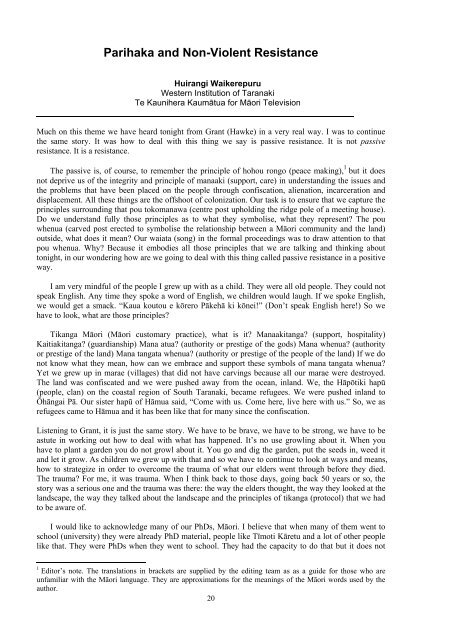traditional knowledge conference 2008 te tatau pounamu
traditional knowledge conference 2008 te tatau pounamu
traditional knowledge conference 2008 te tatau pounamu
You also want an ePaper? Increase the reach of your titles
YUMPU automatically turns print PDFs into web optimized ePapers that Google loves.
Parihaka and Non-Violent ResistanceHuirangi WaikerepuruWes<strong>te</strong>rn Institution of TaranakiTe Kaunihera Kaumātua for Māori TelevisionMuch on this theme we have heard tonight from Grant (Hawke) in a very real way. I was to continuethe same story. It was how to deal with this thing we say is passive resistance. It is not passiveresistance. It is a resistance.The passive is, of course, to remember the principle of hohou rongo (peace making), 1 but it doesnot deprive us of the in<strong>te</strong>grity and principle of manaaki (support, care) in understanding the issues andthe problems that have been placed on the people through confiscation, alienation, incarceration anddisplacement. All these things are the offshoot of colonization. Our task is to ensure that we capture theprinciples surrounding that pou tokomanawa (centre post upholding the ridge pole of a meeting house).Do we understand fully those principles as to what they symbolise, what they represent? The pouwhenua (carved post erec<strong>te</strong>d to symbolise the relationship between a Māori community and the land)outside, what does it mean? Our waiata (song) in the formal proceedings was to draw at<strong>te</strong>ntion to thatpou whenua. Why? Because it embodies all those principles that we are talking and thinking abouttonight, in our wondering how are we going to deal with this thing called passive resistance in a positiveway.I am very mindful of the people I grew up with as a child. They were all old people. They could notspeak English. Any time they spoke a word of English, we children would laugh. If we spoke English,we would get a smack. “Kaua koutou e kōrero Pākehā ki kōnei!” (Don’t speak English here!) So wehave to look, what are those principles?Tikanga Māori (Māori customary practice), what is it? Manaakitanga? (support, hospitality)Kaitiakitanga? (guardianship) Mana atua? (authority or prestige of the gods) Mana whenua? (authorityor prestige of the land) Mana tangata whenua? (authority or prestige of the people of the land) If we donot know what they mean, how can we embrace and support these symbols of mana tangata whenua?Yet we grew up in marae (villages) that did not have carvings because all our marae were destroyed.The land was confisca<strong>te</strong>d and we were pushed away from the ocean, inland. We, the Hāpōtiki hapū(people, clan) on the coastal region of South Taranaki, became refugees. We were pushed inland toŌhāngai Pā. Our sis<strong>te</strong>r hapū of Hāmua said, “Come with us. Come here, live here with us.” So, we asrefugees came to Hāmua and it has been like that for many since the confiscation.Lis<strong>te</strong>ning to Grant, it is just the same story. We have to be brave, we have to be strong, we have to beastu<strong>te</strong> in working out how to deal with what has happened. It’s no use growling about it. When youhave to plant a garden you do not growl about it. You go and dig the garden, put the seeds in, weed itand let it grow. As children we grew up with that and so we have to continue to look at ways and means,how to stra<strong>te</strong>gize in order to overcome the trauma of what our elders went through before they died.The trauma? For me, it was trauma. When I think back to those days, going back 50 years or so, thestory was a serious one and the trauma was there: the way the elders thought, the way they looked at thelandscape, the way they talked about the landscape and the principles of tikanga (protocol) that we hadto be aware of.I would like to ac<strong>knowledge</strong> many of our PhDs, Māori. I believe that when many of them went toschool (university) they were already PhD ma<strong>te</strong>rial, people like Tīmoti Kāretu and a lot of other peoplelike that. They were PhDs when they went to school. They had the capacity to do that but it does not1 Editor’s no<strong>te</strong>. The translations in brackets are supplied by the editing <strong>te</strong>am as as a guide for those who areunfamiliar with the Māori language. They are approximations for the meanings of the Māori words used by theauthor.20
















